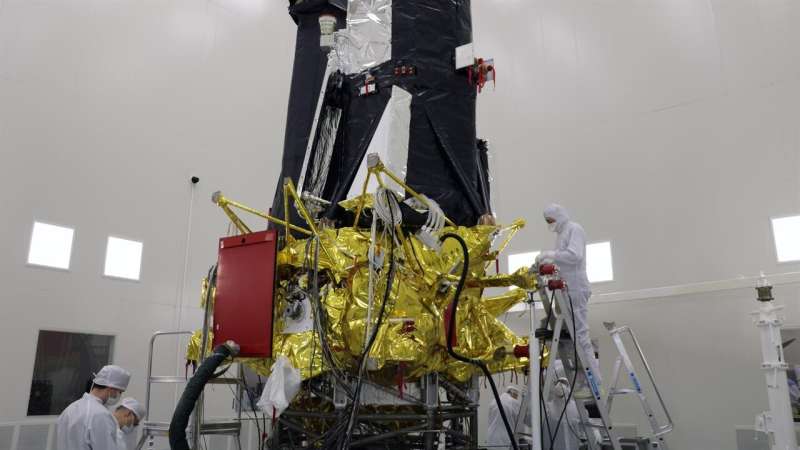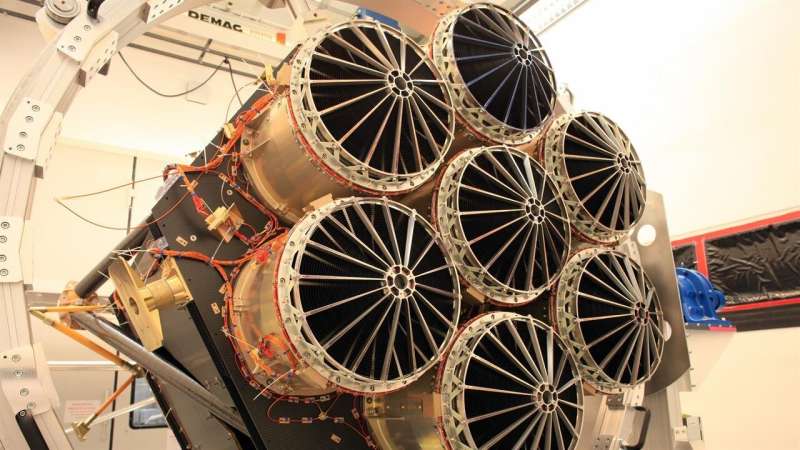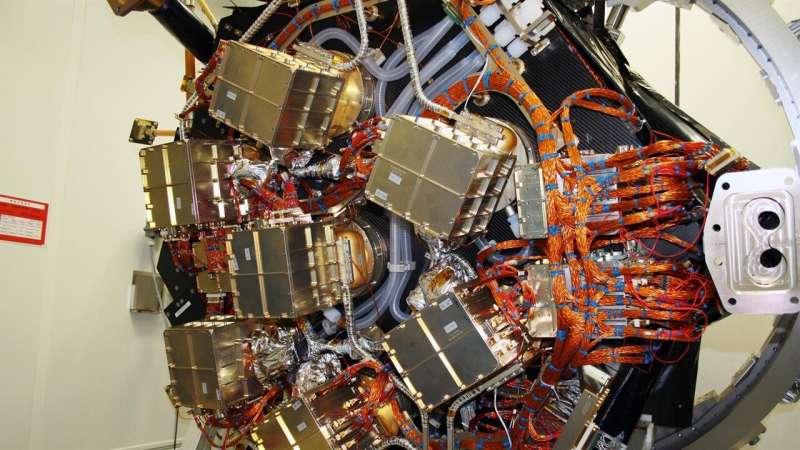Credit: German Aerospace Center (DLR)
On 21 June 2019 the Spektrum-Röntgen-Gamma (Spektr-RG / SRG) spacecraft will be launched from the Kazakh steppe, marking the start of an exciting journey. SRG will be carrying the German Extended ROentgen Survey with an Imaging Telescope Array (eROSITA) X-ray telescope and its Russian ART-XC partner instrument. A Proton rocket will carry the spacecraft from the Baikonur Cosmodrome towards its destination—the second Lagrange point of the Sun-Earth system, L2, which is 1.5 million kilometres from Earth.
In orbit around this equilibrium point, eROSITA will embark upon the largest-ever survey of the hot universe. The space telescope will use its seven X-ray detectors to observe the entire sky and search for and map hot sources such as galaxy clusters, active black holes, supernova remnants, X-ray binaries and neutron stars.
Walther Pelzer, executive board member for the Space Administration at the German Aerospace Center (Deutsches Zentrum für Luft- und Raumfahrt; DLR), says, "eROSITA's X-ray 'eyes' are the best that have ever been launched as part of a space telescope. Their unique combination of light-collecting area, field-of-view and resolution makes them approximately 20 times more sensitive than the ROSAT telescope that flew to space in the 1990s. ROSAT also incorporated advanced technology that was 'made in Germany'. With its enhanced capabilities, eROSITA will help researchers gain a better understanding of the structure and development of the universe, and also contribute towards investigations into the mystery of dark energy."
Credit: German Aerospace Center (DLR)
dark energy—accelerating the expansion of the universe
The universe has been expanding continuously since the Big Bang. Until the 1990s, it was thought that this cosmic expansion would slow down and eventually come to a halt. Then, the astrophysicists Saul Perlmutter, Adam Riess and Brian Schmidt observed stellar explosions that were visible from a great distance and always emitted the same amount of light. They measured their distances and could hardly believe their findings.
"The Type 1a supernovae observed exhibited lower brightness levels than expected. It was clear that the universe was not slowing down as it expanded—quite the opposite, in fact. It is gathering speed and its components are being driven further and further apart at an ever-increasing rate," explains Thomas Mernik, eROSITA Project Manager at the DLR Space Administration. With this discovery, the three researchers turned science upside and were awarded the Nobel Prize in Physics in 2011. Yet Perlmutter, Riess and Schmidt have left us with one crucial question: "What is the 'cosmic fuel' that powers the expansion of the universe? Since no one has yet been able to answer this question, and the ingredients of this catalyst are unknown, it is simply referred to as dark energy. eROSITA will now attempt to track down the cause of this acceleration," explains Mernik.
The first core component of the eROSITA space telescope consists of seven identical mirror modules aligned in parallel. Each has a diameter of 36 centimetres and consists of 54 nested mirror shells whose surface is composed of a paraboloid and a hyperboloid (Wolter I optics). They collect high-energy photons and focus them onto the X-ray cameras. Credit: German Aerospace Center (DLR)
Galaxy clusters—a key to dark energy
Very little is known about the universe. The ingredients that make up 4 percent of its energy density – 'normal' material such as protons and neutrons—is only a very small part of the 'universe recipe'. What the other 96 percent is composed of remains a mystery. Today it is believed that 26 percent is dark matter. However, the largest share, estimated at 70 percent, is comprised of dark energy.
To track this down, scientists must observe something unimaginably large and extremely hot: "Galaxy clusters are composed of up to several thousand galaxies that move at different velocities within a common gravitational field. Inside, these strange structures are permeated by a thin, extremely hot gas that can be observed through its X-ray emissions. This is where eROSITA's X-ray 'eyes' come into play. They allow us to observe galaxy clusters and see how they move in the universe, and above all, how fast they are travelling. We hope that this motion will tell us more about dark energy," explains Thomas Mernik.
The second core component of the telescope is the X-ray camera system. At the focal point of each mirror system is a highly sensitive CCD detector that was specially developed for eROSITA in the semiconductor laboratory at the Max Planck Society. These detectors are a further development of existing X-ray CCD cameras. Credit: German Aerospace Center (DLR)
Map of the entire hot universe—the largest cosmic catalogue
Scientists are not just interested in the movement patterns of galaxy clusters. They also want to count and map these structures. Up to 10,000 such clusters should be 'captured' by eROSITA's X-ray 'eyes' – more than have ever been observed before. In addition, other hot phenomena such as active galactic nuclei, supernova remnants, X-ray binaries and neutron stars will be observed and identified.
eROSITA will scan the entire sky every six months for this purpose, and create a deep and detailed X-ray map of the universe over four years. It will thus produce the largest-ever cosmic catalogue of hot objects and thus improve the scientific understanding of the structure and development of the universe.
eROSITA—seven X-ray 'eyes' looking into the universe
The German telescope consists of two core components—its optics and the associated detectors. The former consists of seven mirror modules aligned in parallel. Each module has a diameter of 36 centimetres and consists of 54 nested mirror shells, whose surface is composed of a paraboloid and a hyperboloid (Wolter-I optics).
"The mirror modules collect high-energy photons and focus them onto the CCD X-ray cameras, which were specially developed for eROSITA at our semiconductor laboratory in Garching. These form the second core component of eROSITA and are located at the focus of each of the mirror systems. The highly sensitive cameras are the best of their kind and, together with the mirror modules, form an X-ray telescope featuring an unrivalled combination of light-collecting area and field-of-view," explains Peter Predehl, eROSITA principal investigator at MPE.
Provided by German Aerospace Center (DLR)


























